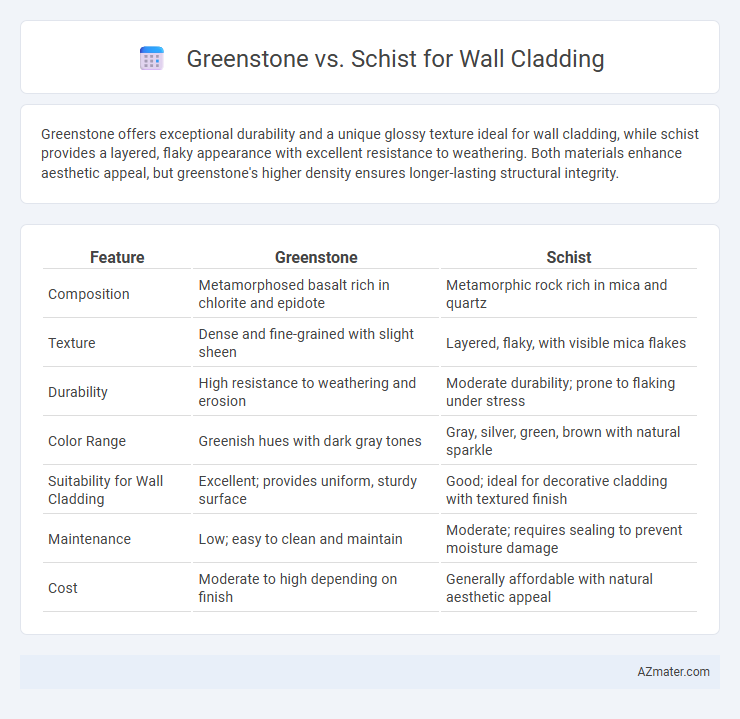Greenstone offers exceptional durability and a unique glossy texture ideal for wall cladding, while schist provides a layered, flaky appearance with excellent resistance to weathering. Both materials enhance aesthetic appeal, but greenstone's higher density ensures longer-lasting structural integrity.
Table of Comparison
| Feature | Greenstone | Schist |
|---|---|---|
| Composition | Metamorphosed basalt rich in chlorite and epidote | Metamorphic rock rich in mica and quartz |
| Texture | Dense and fine-grained with slight sheen | Layered, flaky, with visible mica flakes |
| Durability | High resistance to weathering and erosion | Moderate durability; prone to flaking under stress |
| Color Range | Greenish hues with dark gray tones | Gray, silver, green, brown with natural sparkle |
| Suitability for Wall Cladding | Excellent; provides uniform, sturdy surface | Good; ideal for decorative cladding with textured finish |
| Maintenance | Low; easy to clean and maintain | Moderate; requires sealing to prevent moisture damage |
| Cost | Moderate to high depending on finish | Generally affordable with natural aesthetic appeal |
Introduction to Greenstone and Schist
Greenstone is a dense, metamorphic rock formed from volcanic basalt, known for its durability and unique greenish hue, making it an excellent choice for wall cladding that demands both strength and aesthetic appeal. Schist, a foliated metamorphic rock characterized by pronounced layering and a range of colors, offers a textured, natural look ideal for decorative wall surfaces with enhanced visual depth. Both materials provide resilient, weather-resistant options suitable for exterior and interior cladding applications.
Geological Origins and Formation
Greenstone originates from metamorphosed basaltic lava flows rich in iron and magnesium, formed under low to moderate-grade metamorphic conditions typically found in ancient volcanic belts. Schist is a medium- to high-grade metamorphic rock characterized by pronounced foliation, originating from the metamorphism of mudstones and igneous rocks under higher temperature and pressure conditions deep within the Earth's crust. The distinct geological origins of greenstone and schist influence their textures and durability, making greenstone denser and more durable for wall cladding, while schist offers unique aesthetic with its layered, foliated appearance.
Visual Appearance and Color Variations
Greenstone offers a deep, rich green hue with subtle veining, creating a natural yet elegant appearance ideal for sophisticated wall cladding. Schist displays a broader color palette, from silvery-gray to earthy browns and greens, often featuring pronounced flaky textures that add dynamic visual interest. The choice depends on desired aesthetic impact: Greenstone for uniformity and sleekness, Schist for varied color depth and rustic character.
Physical Properties and Durability
Greenstone offers higher density and compressive strength compared to schist, making it more resistant to abrasion and impact for wall cladding applications. Schist features pronounced foliated textures and lower hardness, which may result in increased susceptibility to weathering and surface erosion over time. Durability tests indicate greenstone's superior resistance to freeze-thaw cycles and chemical weathering, enhancing its longevity in exterior wall cladding installations.
Installation Techniques for Wall Cladding
Greenstone and schist both offer unique installation techniques for wall cladding due to their differing textures and durability. Greenstone typically requires mechanical fixing methods such as stainless steel anchors or clips to ensure secure attachment, as its dense and heavy composition provides strong structural support. Schist, with its foliated layers, benefits from adhesive bonding combined with mechanical fasteners to accommodate its natural cleft surfaces and prevent delamination during installation.
Weather Resistance and Maintenance
Greenstone offers superior weather resistance compared to schist, with its dense, non-porous composition reducing water absorption and minimizing frost damage risks in harsh climates. Schist's foliated structure makes it more susceptible to moisture ingress, leading to potential flaking and higher maintenance requirements over time. Regular sealing and inspections are necessary for schist cladding, whereas greenstone demands less frequent upkeep due to its inherent durability and low porosity.
Cost Comparison and Availability
Greenstone wall cladding typically costs more than schist due to its rarity and complex quarrying process, with prices ranging from $50 to $100 per square foot, whereas schist averages between $30 and $70 per square foot, reflecting its greater abundance and easier extraction. Availability of schist is broader globally, especially in regions like the Northeastern United States and Europe, making it a more accessible option for large projects, while greenstone is often region-specific, found mainly in parts of New Zealand and Canada, which can increase shipping expenses. Project budgets and geographic location heavily influence the cost-effectiveness and sourcing feasibility between greenstone and schist for wall cladding applications.
Sustainability and Environmental Impact
Greenstone offers greater sustainability for wall cladding due to its durability and low maintenance requirements, reducing the need for frequent replacements or repairs. Schist, while visually appealing, often requires more intensive quarrying that can lead to higher environmental degradation and energy consumption. Choosing greenstone supports eco-friendly construction by minimizing carbon footprint and promoting long-lasting material use.
Best Applications for Each Stone
Greenstone offers exceptional durability and resistance to weathering, making it ideal for exterior wall cladding in harsh climates and high-traffic urban settings. Schist's natural shimmer and layered texture provide aesthetic appeal for interior feature walls, fireplaces, and accent walls where visual impact is prioritized. Both stones are compatible with sustainable building practices, but greenstone excels in structural applications while schist suits decorative, indoor environments.
Conclusion: Choosing the Ideal Stone for Wall Cladding
Greenstone offers exceptional durability and resistance to weathering, making it ideal for exterior wall cladding in harsh climates. Schist provides a unique, textured appearance with natural mineral flecks that enhance aesthetic appeal but may require more maintenance due to its softer composition. Selecting between Greenstone and Schist depends on balancing long-term durability needs with desired visual impact for the wall cladding project.

Infographic: Greenstone vs Schist for Wall Cladding
 azmater.com
azmater.com